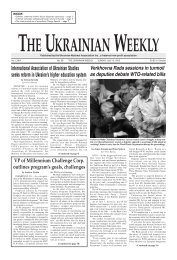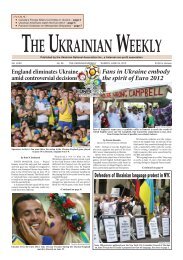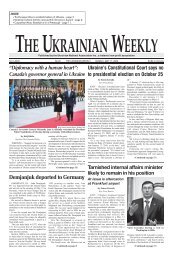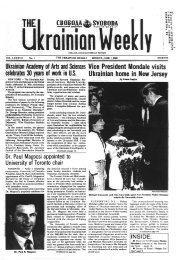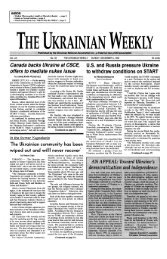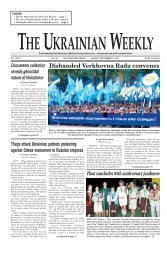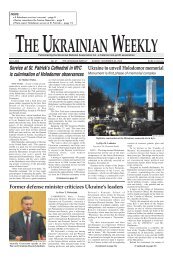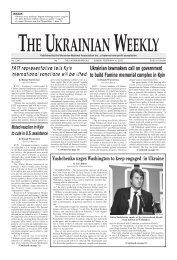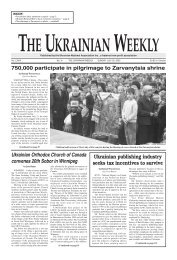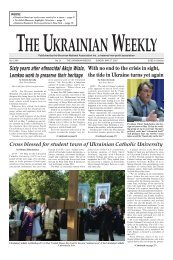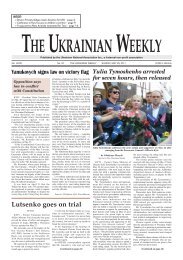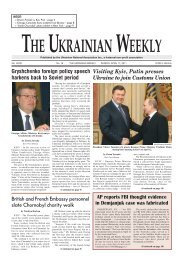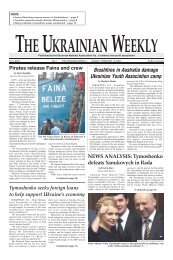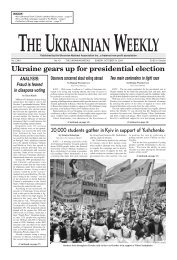Solemn march recalls 10 million victims of Holodomor
Solemn march recalls 10 million victims of Holodomor
Solemn march recalls 10 million victims of Holodomor
Create successful ePaper yourself
Turn your PDF publications into a flip-book with our unique Google optimized e-Paper software.
6 THE UKRAINIAN WEEKLY SUNDAY, NOVEMBER 25, 2007<br />
No. 47<br />
THE UKRAINIAN WEEKLY<br />
Our community united<br />
Saturday, November 17, was a solemn day <strong>of</strong> remembrance for our community<br />
here in the United States. On that day, thousands <strong>of</strong> us traveled to New York City to<br />
participate in the solemn <strong>march</strong> in memory <strong>of</strong> the 7 <strong>million</strong> to <strong>10</strong> <strong>million</strong> <strong>of</strong> our kinsmen<br />
who were systematically killed in the Famine-Genocide <strong>of</strong> 1932-1933. Joined by<br />
hundreds more, the throng filled the Cathedral <strong>of</strong> St. Patrick for a requiem service to<br />
these <strong>million</strong>s <strong>of</strong> innocents. Thanks to the clergy <strong>of</strong>ficiating and the Dumka Chorus<br />
singing the responses, we all were united in fervent and uplifting prayer.<br />
The day’s events were a reaffirmation <strong>of</strong> our nation’s firm intention to seek, not<br />
revenge, but historical justice; to seek to right the wrongs committed to our people by<br />
spreading knowledge and the truth about what occurred in those horrendous years.<br />
The day’s events also marked the beginning <strong>of</strong> a year that has been designated by<br />
the National Committee to Commemorate the 75th Anniversary <strong>of</strong> the Ukrainian<br />
Famine-Genocide <strong>of</strong> 1932-1933 as a year <strong>of</strong> memorial programs, activities, ceremonies,<br />
exhibits, etc. that will culminate in 2008 with the unveiling <strong>of</strong> a monument in<br />
Washington to <strong>victims</strong> <strong>of</strong> the <strong>Holodomor</strong>.<br />
One <strong>of</strong> the most significant and salutary aspects <strong>of</strong> our memorial events on<br />
November 17 was the participation <strong>of</strong> large numbers <strong>of</strong> our younger generations. Yes,<br />
among the <strong>march</strong>ers and mourners were our senior citizens, but there were great numbers<br />
<strong>of</strong> young adults, young families, teenagers, children. Youth organizations, parishes<br />
and schools made a concerted effort to have their young members and students<br />
attend; parents made sure to bring their children.<br />
Thus, the <strong>march</strong> and memorial service became not only a manifestation <strong>of</strong> our<br />
community’s sorrow, but a teachable moment – a time <strong>of</strong> educational opportunity<br />
when a child or teen can be most responsive to learning. And the lessons in this case<br />
are very important.<br />
First <strong>of</strong> all, there is the lesson about the <strong>Holodomor</strong> itself. Reading the banners and<br />
signs being carried and the pamphlets being handed out, and then hearing the speeches<br />
<strong>of</strong> religious, political and community leaders, diplomats and writers – each <strong>of</strong> whom<br />
shed light on a different aspect <strong>of</strong> the Famine-Genocide – the youth <strong>of</strong> our community<br />
was sure to grasp at least some portion <strong>of</strong> the <strong>Holodomor</strong>’s enormity. For many, this<br />
will be food for thought, for discussion, for further reading and research.<br />
And there is yet another lesson in the events <strong>of</strong> November 17, and this is that we all<br />
are part <strong>of</strong> a greater whole, that there are certain truths and values that unite all<br />
Ukrainians. And, these truths and values unite us all regardless <strong>of</strong> religious denomination,<br />
organizational membership, political affiliation, generation, place <strong>of</strong> birth or<br />
Ukrainian-language pr<strong>of</strong>iciency. Our children need to feel they too are a part <strong>of</strong> our<br />
community and to understand its value for all <strong>of</strong> us. Attending such community-wide<br />
events as the one on November 17 nurtures and strengthens that feeling.<br />
A year from now in Washington, we will come together yet again as a community<br />
united in sorrow and in purpose. Meanwhile, between now and then, all <strong>of</strong> us can continue<br />
our work – as one community – to seek universal recognition <strong>of</strong> the <strong>Holodomor</strong>.<br />
Nov<br />
30<br />
2003<br />
Turning the pages back...<br />
Four years ago on the eve <strong>of</strong> the 70th anniversary commemorations<br />
<strong>of</strong> the <strong>Holodomor</strong>, the Pulitzer Prize Board announced that<br />
after six months <strong>of</strong> study and deliberation, it would not posthumously<br />
take away Walter Duranty’s 1932 Pulitzer Prize, as reported<br />
by The Ukrainian Weekly on November 30, 2003.<br />
The announcement on November 21, 2003, came after a semiannual meeting <strong>of</strong> the 17-<br />
member board held at Columbia University in New York City.<br />
A portfolio <strong>of</strong> 13 articles was reviewed by the Pulitzer Prize Board and measured according<br />
to current standards for foreign reporting. A statement that followed the review said that<br />
the articles fell seriously short <strong>of</strong> the current standards and agreed that their findings were<br />
similar to that <strong>of</strong> scholars like Dr. Mark von Hagen <strong>of</strong> Columbia University, who found the<br />
articles to be “cynical in tone and apologist in purpose and effect in terms <strong>of</strong> justifying what<br />
the Stalinist regime was up to.” The New York Times called Mr. Duranty’s work “slovenly”<br />
but did not see it fit to remove the award from Mr. Duranty’s journalistic record. Justifying<br />
the board’s decision not to revoke Mr. Duranty’s award, the board said “there was not clear<br />
and convincing evidence <strong>of</strong> deliberate deception, the relevant standard in this case.”<br />
Dr. Lubomyr Luciuk <strong>of</strong> the Ukrainian Canadian Civil Liberties Association, which initiated<br />
the international campaign for the revocation <strong>of</strong> Mr. Duranty’s prize, said, “It is a documented<br />
fact that Duranty was Stalin’s apologist, a shill for the Soviets before, during and<br />
after 1932-1933. For the Pulitzer Prize Committee to render this tartuffish decision and<br />
announce it on the eve <strong>of</strong> the fourth Saturday in November, a day <strong>of</strong>ficially set aside in<br />
Ukraine for national mourning, is base.”<br />
According to the Pulitzer Prize Board, the prize is not awarded for an author’s body <strong>of</strong><br />
work, or for the author’s character, but for the specific pieces entered into the competition.<br />
The 13 articles under review for the prize were written and published in 1931.<br />
Dr. Luciuk said that those articles under review were “nothing more than a regurgitation<br />
<strong>of</strong> the <strong>of</strong>ficial Soviet line.” The Pulitzer Prize Board, he continued, was “concentrating on<br />
minutiae and ignoring the greater truth. It’s a sleight <strong>of</strong> hand.”<br />
“All who hold a Pulitzer Prize should think about whether what was once the most prestigious<br />
distinction in journalism still is. Duranty’s prize soils all Pulitzer Prizes,” Dr. Luciuk<br />
added.<br />
A statement issued by the Pulitzer Prize Board said, “The famine <strong>of</strong> 1932-1933 was horrific<br />
and has not received the international attention it deserves. By its decision, the board in<br />
no way wishes to diminish the gravity <strong>of</strong> that loss. The board extends its sympathy to<br />
Ukrainians and others in the United States and throughout the world who still mourn the<br />
suffering and deaths brought on by Joseph Stalin.”<br />
Source: “Pulitzer Board declines to revoke Duranty’s prize,” by Andrew Nynka, The<br />
Ukrainian Weekly, November 30, 2003.<br />
LETTERS TO THE EDITOR<br />
Two New York events<br />
worth experiencing<br />
Dear Editor:<br />
Brian Cherwick was in town a couple<br />
<strong>of</strong> weeks ago. In case you don’t know <strong>of</strong><br />
him, Mr. Cherwick is a renowned<br />
Ukrainian Canadian musician from<br />
Edmonton, Alberta. He was in New York<br />
City participating in the “Sounds <strong>of</strong> the<br />
Prairies: Music and Dance <strong>of</strong> the<br />
Ukrainian Settlers <strong>of</strong> Western Canada”<br />
program sponsored by the Center for<br />
Traditional Music and Dance as part <strong>of</strong><br />
its “Ukrainian Wave” series. This series<br />
ran from October 16 to 22, and I was<br />
able to attend two <strong>of</strong> the events.<br />
The first event I attended was the<br />
“Sounds <strong>of</strong> the Prairies” concert at The<br />
Ukrainian Museum on October 19. This<br />
program was organized by the CTMD<br />
and by Julian Kytasty <strong>of</strong> the New York<br />
Bandura Ensemble as part <strong>of</strong> the<br />
Bandura Downtown series. This concert<br />
featured Mr. Cherwick playing tsymbaly,<br />
sopilky, accordion, guitar, lira and koza,<br />
accompanied by Sprocket Royer on<br />
acoustic bass, and Valery Zhmud on violin,<br />
with Halya Remezova joining in on<br />
violin for a few pieces. Mr. Cherwick<br />
played a variety <strong>of</strong> songs, ranging from<br />
traditional Ukrainian dance melodies to<br />
old-time Ukrainian prairie dance tunes<br />
and a Ukrainian Canadian version <strong>of</strong><br />
Woody Guthrie’s “This Land Is Your<br />
Land.” He also played a few <strong>of</strong> his own<br />
songs from his group, the Kubasonics,<br />
songs about the wholesome goodness <strong>of</strong><br />
kyshka and about baba rolling her own<br />
holubsti. We heard the full gamut <strong>of</strong><br />
songs. If this had been the only concert I<br />
had seen, I would have been greatly satisfied.<br />
However, I went to the event the next<br />
night, on Saturday, October 20, which<br />
was held in the hall at the Ukrainian East<br />
Village Restaurant. This was the<br />
“Western Canadian Vechornytsi,” a western<br />
Canadian prairie village dance, if you<br />
will. The evening started out with Andriy<br />
Nahachewsky, the dance master from the<br />
University <strong>of</strong> Alberta. He taught us a<br />
number <strong>of</strong> dances from western Canada,<br />
dances that are still done as they were<br />
done in Ukraine a hundred years ago.<br />
These included the “chaban,” “syidemka,”<br />
“kolomyika,” “verkhovyna,” “toeheel<br />
polka” and the “arkan.”<br />
The high point for me was the arkan,<br />
learning all the steps that can be done.<br />
Okay, maybe not all the steps – as<br />
Andriy said that there are many variants,<br />
but he taught us more than enough steps<br />
to show <strong>of</strong>f with.<br />
The music for these dances was provided<br />
by Mr. Cherwick on accordion and<br />
tsymbaly, Mr. Royer on acoustic bass,<br />
Andriy Milavsky (<strong>of</strong> the group Cheres)<br />
on various sopilky and clarinet, Ms.<br />
Remezova on violin, Stefan Kuziv playing<br />
the drum/cymbal/bells kit, and joining<br />
in later, Peter Rushefsky (<strong>of</strong> the<br />
CTMD) on tsymbaly. It was nicely<br />
played music to learn to dance to.<br />
After about an hour <strong>of</strong> dance lessons,<br />
the dance started. At first the musicians<br />
We welcome your opinion<br />
played for us, but then ... let’s just say<br />
that the music soon dissolved into the<br />
musicians playing more and more difficult<br />
or unknown songs, teaching the<br />
other musicians old songs, showing <strong>of</strong>f<br />
... This became an “all star” jam session<br />
that we had the privilege <strong>of</strong> watching and<br />
listening. What a treat!<br />
Mr. Cherwick on accordion traded <strong>of</strong>f<br />
leads with Mr. Milavsky on sopilky and<br />
clarinet. Mr. Royer, on bass, kept a solid<br />
rhythm that swung just so nicely. Mr.<br />
Kuziv added to that with his percussion<br />
kit. Ms. Remezova played violin. By the<br />
end <strong>of</strong> the evening, I was sure that her<br />
violin strings were glowing red-hot – she<br />
is that good. Mr. Rushefsky, the music<br />
director at CTMD, filled out the songs<br />
on the tsymbaly, completing the group.<br />
What did they play We had polkas,<br />
arkans, kolomyiky, waltzes, <strong>march</strong>es and<br />
many, many more. To give you an idea<br />
<strong>of</strong> the quality and caliber and level <strong>of</strong> the<br />
musicianship and vast musical knowledge<br />
<strong>of</strong> this group, the last song that was<br />
played featured Messrs. Cherwick and<br />
Rushefsky on tsymbaly, vocals by Mr.<br />
Kuziv, and an unknown piano player.<br />
They played “Skhody Do Neba,” the<br />
song made popular by that British group<br />
“Olyvianyi Zepelyn” (Led Zeppelin).<br />
The talent, the musicianship, the<br />
music – I am still abuzz even as I write<br />
this. Let’s just say that one will not see<br />
or hear music like this again any time<br />
soon – this was a true musical experience.<br />
Ihor Slabicky<br />
Portsmouth, R.I.<br />
Ukrainians’ skepticism<br />
about agricultural land<br />
Dear Editor:<br />
Earlier this year, Ukraine’s Parliament<br />
reaffirmed a law prohibiting the sale <strong>of</strong><br />
agricultural land. It can be inherited or<br />
leased from current owners – who were in<br />
collective farms during the Soviet era.<br />
This arrangement apparently is favored<br />
by most Ukrainian citizens. Having lived<br />
through privatization scandals in the<br />
1990s, Ukrainians seem to be very skeptical<br />
<strong>of</strong> the virtues <strong>of</strong> marketing agricultural<br />
land. Land is just about the only major<br />
asset not yet gobbled up by a handful <strong>of</strong><br />
oligarchs.<br />
There are good reasons to be skeptical.<br />
Examples <strong>of</strong> most countries with market<br />
economies show what happens when land<br />
is a marketed commodity. In the United<br />
States, family farms are an endangered<br />
species. Only a small fraction still exist.<br />
Most land is cultivated by large agro-businesses<br />
with hired labor, many <strong>of</strong> them<br />
migrant workers living in dismal conditions.<br />
The saga <strong>of</strong> farm worker abuse to<br />
this day stains America’s conscience. Not<br />
much has changed since the days <strong>of</strong> John<br />
Steinbeck’s “The Grapes <strong>of</strong> Wrath” and<br />
Caesar Chavez’s struggle for union recognition.<br />
This is not a world <strong>of</strong> purist con-<br />
(Continued on page 22)<br />
The Ukrainian Weekly welcomes letters to the editor and commentaries on a variety <strong>of</strong><br />
topics <strong>of</strong> concern to the Ukrainian American and Ukrainian Canadian communities.<br />
Opinions expressed by columnists, commentators and letter-writers are their own and do<br />
not necessarily reflect the opinions <strong>of</strong> either The Weekly editorial staff or its publisher, the<br />
Ukrainian National Association.<br />
Letters should be typed and signed (anonymous letters are not published). Letters are<br />
accepted also via e-mail at staff@ukrweekly.com. The daytime phone number and address <strong>of</strong><br />
the letter-writer must be given for verification purposes. Please note that a daytime phone<br />
number is essential in order for editors to contact letter-writers regarding clarifications or<br />
questions. Please note: THE LENGTH OF LETTERS CANNOT EXCEED 500 WORDS.



